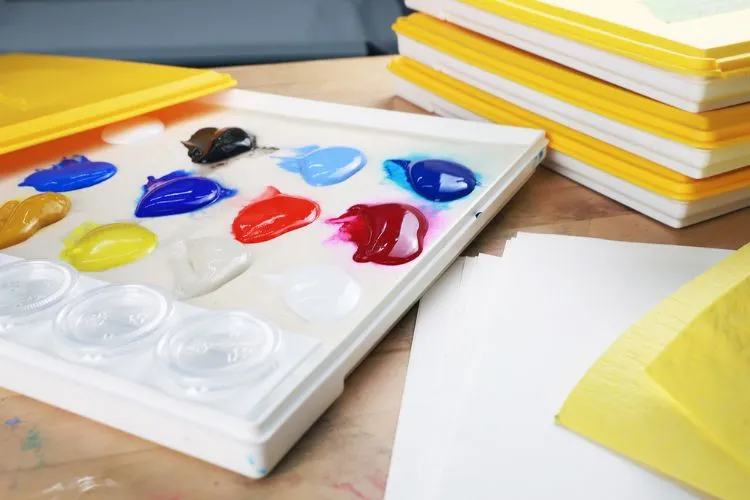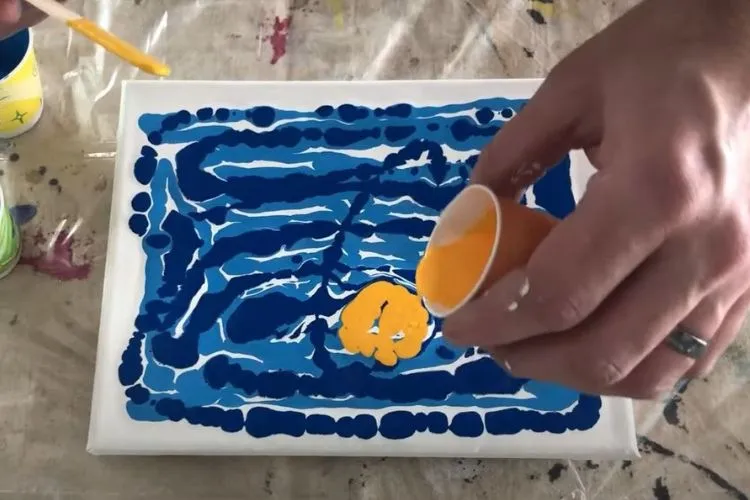Understanding how long acrylic paint takes to dry is crucial for artists who use this medium. Acrylic paint is known for its versatility and the vibrant colors it offers.
However, its drying times vary based on several factors. Grasping these factors helps artists plan and execute their projects with precision. Let’s learn how long does acrylic paint take to dry.

How Long Does Acrylic Paint Take to Dry?
Acrylic paint drying times can be influenced by many conditions.
These include the thickness of the paint application, the type of surface painted on, and the environmental conditions at the painting location.
Thickness of the Application
The thickness of the acrylic paint applied plays a significant role in its drying time. Thin layers of paint dry quickly, often in a few minutes to an hour. This is because the smaller volume of paint allows water and solvents to evaporate rapidly.
In contrast, thicker applications, such as those created with impasto techniques, can take days to dry completely. The outer layer might feel dry to the touch, but the paint beneath can still be wet.
Type of Surface
The surface on which acrylic paint is applied also affects its drying time. Porous surfaces like unprimed canvas or wood absorb more of the paint’s water content, accelerating the drying process.
On the other hand, less absorbent surfaces, such as primed canvas or plastic, may slow down the drying time because the water and solvents in the paint evaporate more slowly.
Environmental Conditions
Environmental factors such as temperature, humidity, and airflow play a significant role in drying times. Warm temperatures and low humidity levels facilitate faster drying by promoting the evaporation of water from the paint.
High humidity slows down this process. Likewise, a well-ventilated space encourages quick drying by moving air over the painted surface, carrying away the moisture.
Stages of Acrylic Drying

Understanding the stages of acrylic paint drying is vital for artists. These stages include surface drying and curing time.
Surface Dry
When acrylic paint is surface dry, it feels dry to the touch. This stage is deceptive because, while the top layer might not be tacky, the paint underneath might not have fully dried.
This stage typically occurs within minutes to a few hours after application, depending on the factors previously discussed.
Cure Time
Cure time refers to the period it takes for acrylic paint to completely dry and achieve its full durability. This process is lengthier than surface drying, taking up to several weeks.
During this time, the paint undergoes chemical changes, becoming fully resistant to water and mechanical stress. Understanding cure time is crucial when considering the application of varnishes or transporting the artwork.
You may also find useful: How to Make Acrylic Paint Dry Faster? | Why Is My Acrylic Paint Not Drying?
Tips to Control Acrylic Paint Drying Time
Having control over how quickly or slowly acrylic paint dries can be beneficial for artists. This control allows them to work with the medium in a way that suits their project needs.
Accelerating Drying Time
Artists looking to speed up the drying process can use several techniques. Working in a warm, dry environment or using a hair dryer can reduce drying times significantly.
Additionally, incorporating drying mediums into the paint can hasten the process. These mediums are formulated to evaporate quickly, taking the paint’s water content with them.
Slowing Down Drying Time
Sometimes, slowing down the drying time of acrylic paint is desirable, especially when blending colors or working on intricate details.
Using slow-drying mediums or keeping a wet palette can keep the paint workable for longer periods. These techniques provide artists with the flexibility to adjust their work without rushing.
Materials That Affect Drying Time

The drying time of acrylic paint can vary significantly based on its chemical composition and the materials used. Different pigments may dry at different rates; for example, heavier or more dense pigments might take longer to dry compared to lighter ones.
Moreover, the brand of acrylic paint can also influence drying times as higher-quality paints often contain less filler and more pigment, which can enhance drying speed.
Additives play a critical role too; some acrylic paints include retarders that slow the drying time to allow more workability, while others contain accelerators to speed up the process.
Understanding these variations can help artists make more informed choices about the materials they use for specific effects and techniques.
Frequently Asked Questions (FAQs)
How can I tell if my acrylic painting is fully cured?
Acrylic paint is fully cured when it is no longer tacky and has reached its maximum hardness. This can take several weeks. Avoid heavy handling or varnishing until this period has passed.
Can I varnish my painting if it feels dry to the touch?
It’s best to wait until the paint has fully cured before applying varnish. While the surface may feel dry, the layers underneath might not be, risking damage or complications from premature varnishing.
Does brand quality affect drying time?
Yes, the quality of acrylic paint can affect drying times. Higher-quality paints often contain more pigments and less filler, leading to more consistent and sometimes faster drying times.
What precautions should I take if I need to transport a painting that is not fully cured?
If transportation is necessary, protect the painting’s surface from contact with packaging materials. Wrap the painting in air-permeable, but protective layers, and avoid pressure on the painted surfaces.
How do environmental factors specifically affect drying and curing times?
Warm, dry, and breezy conditions promote faster drying by enhancing evaporation of water from the paint. High humidity and cold temperatures do the opposite, slowing both surface drying and curing processes.
Conclusion:
Understanding the drying times of acrylic paint is essential for artists. It affects how they plan their projects, apply the paint, and finish their artwork.
By considering the thickness of the paint application, the type of surface used, and the surrounding environmental conditions, artists can better manage the drying process.
Additionally, techniques to either accelerate or decelerate drying times can help cater to specific project needs.
Patience and careful planning ensure the longevity and durability of the finished piece. Experimenting with these variables enables artists to achieve the best results for their acrylic paintings.

Meet Isabella Anderson, your acrylic painting mentor with over a decade of brush-wielding mastery. Dive into the colorful world of acrylics with her expert guidance, featured exclusively on ‘Acrylic Authority.’ Unleash your inner artist and explore the limitless possibilities of this versatile medium alongside a true acrylic aficionado.
